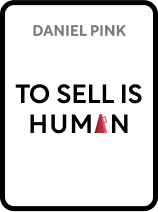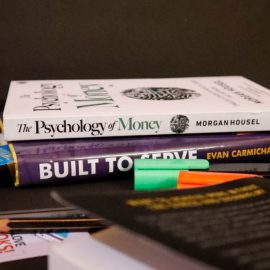

This article is an excerpt from the Shortform book guide to "To Sell Is Human" by Daniel H. Pink. Shortform has the world's best summaries and analyses of books you should be reading.
Like this article? Sign up for a free trial here .
Think selling is just for salespeople? Think again. Daniel Pink’s To Sell Is Human flips that assumption on its head. Whether you’re pitching an idea to your boss, convincing your kid to eat vegetables, or actually selling a product, you’re using sales skills every single day.
In his book, Pink shows us that the old-school “always be closing” mentality is dead. Today’s world demands something different: connection, optimism, and a genuine focus on serving others. Read on to discover how to master the art of moving people.
Overview of To Sell Is Human
Selling is an intrinsically human skill that has evolved with us over time. In his book To Sell Is Human, Daniel Pink explores how deeply embedded this skill is in our lives and shows you how to harness it as a tool for achieving results in sales, as well as other areas of life. Our overview supports, contrasts, and simplifies Pink’s ideas so you can put them into action in your own life.
Everyone’s a Salesperson
Despite sales traditionally being a specialized skill set, Pink argues that the modern workplace managed to transform us all into “sellers.” Workers now generally find themselves needing to use sales skills to “move” their target demographic, whether or not they are selling a material product. Thus, Pink introduces a new term: non-sales selling (or contemporary selling). Contemporary selling is about moving others to exchange resources that can include but do not revolve around money. Haggling over a product price, asking someone on a date, and interviewing for a job all use contemporary selling.
| When Did We All Become Salespeople? The idea that selling is inherent in the human experience isn’t new. As far back as the 1800s, Scottish novelist Robert Louis Stevenson wrote, “Everyone lives by selling something.” That said, the idea has taken hold more noticeably in the modern workplace for the practical and emotional reasons Pink has outlined. Whether you’re persuading people to accept your ideas, your products, or you yourself, your ability to sell is both natural and necessary to get what you want out of your experience of life. |
The Traditional ABCs of Sales
In Pink’s view, sales has historically been seen as deceitful and manipulative, but the power balance has changed, and there are two primary sales philosophies now: The traditional philosophy of “buyer beware,” or caveat emptor, and the new philosophy of “seller beware,” or caveat venditor. Caveat emptor doesn’t require integrity, as its sole purpose is to benefit the seller. Caveat venditor is about the seller being of service to the buyer. Whereas before, integrity was the last value a salesperson operated from, being a successful salesperson now requires it.
Traditional Sales Philosophy
The economy during the heyday of traditional sales (the better half of the 1900s) was stable and predictable, and it prioritized consumerism. Pink explains that the traditional salesperson focused on a singular objective: making a profit. This is represented by the popular sales acronym “ABC”: Always Be Closing.
This philosophy meant that the traditional salesperson didn’t have to care about the needs of the buyer, as long as they made their sale. It encouraged sellers to use any means necessary to exploit buyers, which consequently created a negative view of salespeople.
For example, suppose you were a traditional car salesperson. To make the best possible profit, you’d misrepresent the quality of your vehicles and charge more than they were worth. You were willing to take advantage of the buyer in order to make the sale.
(Shortform note: Where did the ABC mantra come from? In 1992, Alec Baldwin played a salesman in the movie Glengarry Glen Ross (originally an award-winning play by David Mamet) and popularized the phrase “A-B-C. A-Always, B-Be, C-Closing. Always be closing!” Baldwin’s character was the epitome of the “pushy salesman,” single-mindedly focused on making the sale, whether or not it benefited the buyer.)
What Changed?
Two factors initiated the decline of traditional sales.
Change #1: Economic Disruption
The economy, previously predictable, became unstable in the Great Recession, which soon transformed the workforce. It forced workers to broaden their skill sets to help companies cut costs. Skill sets like sales, which had previously been specializations, became basic necessities for everyone in order to increase efficiency in organizations. The economic instability also inspired a wave of entrepreneurs. Self-starters often need to wear many hats, which contributed to the need for flexible skill sets including sales.
(Shortform note: As sales skills have become more critical for workers, so have interpersonal or “soft” skills, which are closely related: To sell, you need to be able to relate to people. So it’s not surprising that both skill types are in increasing demand in response to the changing economy. Specifically, soft skills include social skills, emotional intelligence, time management, and handling conflict effectively.)
Change #2: Technology Boom
Pink explains that sales previously depended on a power imbalance between buyer and seller. Pre-technology, the sellers had all the important information, and the buyers had none. This gave the power to the sellers and allowed them to prioritize their own success over the needs of the buyer to turn a profit. With the internet giving everyone access to the same information, sellers were forced to shift their focus from profit to serving the buyer’s needs.
(Shortform note: It might be tempting to argue that entrepreneurs are more visionaries than salespeople, but as Pink notes, entrepreneurs tend to wear all the hats, requiring a more diverse skill set to ensure business success. The majority of these skills involve sales because you need to be able to sell your brand and the uniqueness and usefulness of your product.)
The Modern ABCs of Sales
The economic and technological changes gave rise to a new philosophy of selling that replaces the old ABCs, according to Pink. In contrast to the seller making a profit, the new method is aimed at meeting the buyer’s needs with three approaches: connection, optimism, and focus.
Contemporary Selling Step 1: Connection
Pink defines connection as getting in sync with and adapting to people, communities, and contexts in order to serve their needs.
(Shortform note: While empathy and connection are frequently used interchangeably, connection goes beyond empathy. In the context of sales, empathy is about having the ability to understand what a buyer needs or a problem they need solved, building trust, and creating connection; in the context of sales, connection allows you to look at the world through the eyes of the buyer, and try on their perspective to understand their needs.)
Pink suggests three techniques for practicing connection.
Technique #1: Mimicking
He says mimicking builds trust between seller and buyer, because people trust others who share their mannerisms or subtly mirror them in other ways. For example, if you’re a seller and notice that a buyer is physically expressive when they talk, you can use more physical gestures. This should help to create camaraderie.
(Shortform note: While mimicry can create rapport, it can undermine it when done in inappropriate contexts or inappropriate ways. It can actually upset people, preventing positive rapport both consciously and subconsciously.)
Technique #2: Perspective Taking
Pink’s second way of connecting is to develop a deeper understanding of the buyer and the context of their needs by putting yourself in their shoes. You can use your imagination to consider the buyer’s bigger picture and see needs to serve that you would have missed with a focus on your own perspective or experience.
For example, say you’re selling a car to a buyer. They’re a new driver, and they’re looking at trucks, initially. You notice they’re a fairly small person, and considering that factor along with the new driver status, you suggest a line of smaller sports cars. You think the cars will be easier to handle for a new driver, especially one who is on the smaller side. The customer buys a cool, safe sports car. They say it’s a perfect fit, and they’re glad they didn’t go with one of the trucks.
(Shortform note: To consider someone else’s perspective, 1) identify your own perspective (what is the conflict about, how do I feel about it, and how will I respond?); 2) explore the other person’s perspective (how does she see the conflict, how might she feel about it, and what are her motivations?); and 3) reflect on your original perspective, noting whether it’s changed.)
Technique #3: Power Shifting
Pink’s third technique for connection is to treat the buyer like they’re the ones with the power. This creates a dynamic of service, where you can focus on meeting their needs instead of your own interests.
For example, when you are selling to someone, consider sitting at an equal level with them and asking, “What are you looking for, and how can I help?” This physically puts you on an even playing field, and the question sets you up for a dynamic of service.
(Shortform note: Keep in mind that while power makes you more productive, it also makes you less empathetic: You don’t care as much about getting along with others and you’re more focused on your own needs than the needs of others. This underscores Pink’s advice to mentally shift power to the buyer to create a service dynamic in sales.)
Contemporary Selling Step 2: Optimism
The second component of Pink’s modern sales method is optimism. Optimism is crucial because it helps you develop resilience. Selling involves hearing the word no more often than yes, so you need to believe in what you’re selling enough to see a transaction through, even when a buyer initially resists buying (or to move on to the next customer if they refuse to buy).
For example, say you’re a door-to-door salesman, and you manage to get into conversation with a potential buyer. The prospect hasn’t closed the door in your face yet but seems to be rejecting everything you have to say. With an optimistic attitude, you can stay positive about the outcome and show the buyer how much you believe in your product or service. Even if the buyer ultimately doesn’t purchase, you develop the resilience to approach the next potential buyer.
| The Power of Optimism Beyond simply boosting your morale, optimism significantly increases your ability to sell. In one study, MetLife, which hired thousands of salespeople per year, gave their new hires both an “optimism test” and a sales aptitude test. In the first year, new hires who passed both tests achieved an 8% higher success rate than those who only passed the aptitude test. By the second year, this percentage increased to 31%. Even more importantly, those who scored high on the optimism test but low on the aptitude test achieved a 21% higher success rate in their first year than those who passed just the aptitude test, and by their second year, this rate jumped to 57%. |
Pink recommends building optimism into three stages of the sales process: your preparation, your handling of the sales conversation, and your evaluation afterward.
Prepare: Question Yourself
To prepare for a sales interaction, Pink advises asking yourself targeted, positive questions that help you focus on your sales goals. This boosts your confidence and motivation, and done consistently, it leads to better long-term results.
For example, before a potential sale, ask yourself, “How can I best be of service to this buyer?” Or, “How can I show the buyer this purchase is worth it?”
(Shortform note: Sales experts note that when you use interrogative self-talk to prepare for a sales interaction, it’s important to focus your questions within categories that sharpen your understanding of your buyer’s specific needs. The goal is to know exactly who you are, who your buyer is, and what value you bring to the transaction. This builds both confidence and optimism.)
Maintain: Communicate Positivity
After building optimism into your preparations, the next step is to maintain it during the sales process. It’s important to create a positive environment during a sale, both internally (for the seller), and externally (for the buyer).
Research indicates that there is a “golden ratio” of positive to negative experience. When you experience three positive sensations to one negative sensation, your well-being improves. When you experience 11 positive sensations to one negative sensation, your well-being decreases. A healthy ratio of positive to negative sensations makes the buyer more receptive, and more likely to take positive action (like make a purchase). Additionally, as a seller, when you feel positively about your product, as well as the sales process, you can more easily connect with the buyer. This increases buyer trust.
Put this information into practice by creating a friendly atmosphere, communicating positive information with a minimum 3 to 1 (and maximum 11 to 1) ratio to negative information, and speaking with conviction about what you are selling. For example, if you’re selling a car, share a number of positive aspects of the car, and then throw in a negative. Smile often, and speak highly of the across-the-board quality of the cars you sell.
(Shortform note: While there is little doubt that positive experiences improve well-being, there is doubt about the legitimacy of the golden ratio rule. According to some researchers, there is no scientific evidence that the mathematical formula the golden ratio theory is based on can be applied to feelings and well-being.)
Evaluate: Reflect With Optimism
After you complete a sales interaction, reflect on what went well. Studies show that the way we describe an experience after the fact influences how we feel about it. To reflect positively, Pink recommends starting with these three assumptions when describing a sales experience.
- Negative experiences are temporary.
- Negative experiences are circumstantial.
- Negative experiences are not personal.
| Victim Mentality Versus Growth Mindset In a sales context, a victim mentality based on negative thought patterns is detrimental and ultimately leads to chronic learned helplessness. When you see yourself as a victim, you prevent sales success because you begin to feel powerless and expect failure. A growth mindset leads to flexible optimism, supporting sales success by creating a sense of empowerment, confidence, and optimism. A growth mindset looks like: • An emphasis on effort • A foundation of self-discipline • A resilient attitude • A sense of ownership • A willingness to take creative initiative |
Contemporary Selling Step 3: Focus
The third component of Pink’s modern sales model is creating focus, or helping customers get clarity on their needs. This entails finding problems, drawing the customer’s attention to them, and offering solutions.
For example, say you’re a tutor and a life coach. Your tutoring client is a 12-year-old boy who can’t get his grades up. You notice that he’s very smart, and you realize his grades are only low because he doesn’t have self-discipline skills (you’ve found the problem). You offer to provide him with life coaching instead of tutoring (an effective solution). His grades quickly improve.
| Focus in the Midst of Noise Your biggest challenge as a seller is to cut through the “noise” and get to the heart of your buyers’ needs. Noise can be anything that distracts from what you’re offering (examples include services that are more exciting or create a stronger sense of urgency, or any other ways buyers can spend their resources elsewhere). Create an environment for your buyer that helps them to focus on you and what you’re offering. One way to do this is by directly acknowledging and demystifying the noise upfront. For example, if you’re selling a cell phone service, you might identify each of your competitors by name and briefly note the ways they don’t serve your buyer’s needs. |
Pink identifies several ways of creating focus for a customer.
#1: Problem Finding
While the traditional sales approach is about making the sale (problem solving), Pink’s method is about helping buyers clarify their needs (problem finding). You can enhance your problem-finding skills by being thorough, asking good questions, considering multiple perspectives, and staying adaptable.
For example, when you work with a new buyer, get to know them by asking questions. You can use the information you discover to help your buyer focus on their needs and decide on a solution.
(Shortform note: According to Einstein, identifying a problem is more important than solving a problem, because solving a problem requires little imagination—just the ability to engage in trial and error and to use logic. Identifying a problem requires creativity and asking innovative questions, and it unlocks new possibilities that didn’t seem to exist prior to the identification process.)
#2: Creating Contrast
Research shows we understand things more clearly when we see them in contrast with other things. You can help buyers develop focus by showing them multiple potential paths they can compare, or by using an unfavorable option to highlight the benefits of a more favorable one.
For example, if you’re selling a car, have multiple cars ready to show to the buyer, including one of lower quality than the others, which you can use to highlight the benefits of the other cars.
| The Contrast Principle: Influencing Focus In The Psychology of Persuasion, Robert Cialdini explores how comparison shapes the way we perceive things and how that can be harnessed for sales success. According to Cialdini, when we experience two things at the same time or one after another, we automatically compare the value of the second to the value of the first. Our opinion about the second item is heavily influenced by the way we perceive the first item. For example, if you’re buying curtains, and the salesperson first shows you a set that you find ugly, followed by a set that you’d consider average on their own, the second set will seem better looking in comparison to the first set. You’re more likely to buy the average set than you would have been had they been the only option you were given. |
#3: Selling Experience
Another way to help customers focus is to sell experiences rather than products. Experiences facilitate connection and opportunities for joy or growth. Framing a sale through the lens of experience focuses a buyer on how they will benefit and is more likely to get them emotionally invested in making a purchase.
For example, rather than selling a “cellphone,” sell a “tool for staying connected to the people you care about.” This keeps the buyer focused on the purpose of the phone and how it will bring them a positive experience.
(Shortform note: Experiences often resonate more than products because experiences are easier to relate to: You’ll connect more meaningfully to your buyer if you emphasize your experience with it (for example, “I have a passion for photography, so having the largest storage option on my phone allows me to hold onto all those memories”). Additionally, modern buyers care more about what they do than about what they own (for instance, 72% of millennials prefer experiences to products).)
#4: Providing a Path
People are more inclined to act when they have a path to follow. Pink recommends providing buyers with a clear path to solving their problem (ideally one that requires the least amount of effort possible).
For example, a therapist doing a consultation with a potential client can assess their therapy goals, then provide them with a structured timeline for meeting those goals. To keep it simple, she can offer them a package of sessions instead of having them pay as they go. Giving them clear steps and a clear time frame makes them more likely to commit to working with her.
| The Power of the Call to Action A call to action makes it easy for the buyer to take an immediate, specific action. When you don’t include a call to action, or steps the buyer can take, in your sales pitch, you are more likely to lose a sale or a customer. There are two lines of thinking that lead to this pitfall: • Assuming that the buyer has enough clarity and motivation to take action on their own. • Fear that a call to action is too aggressive and will push the buyer away. Even if a buyer knows what they want, always give them clear information and directions. This will ensure a smooth closure of the sale. Rather than overwhelming buyers, having a clear, simple path to take relieves them of the pressure to act from uncertainty. |
The New Paradigm: Say Goodbye to Sales & Hello to Service
Pink argues that the contemporary sales method is ultimately about providing a service to others. This means you should sell with the intent to improve someone else’s life.
He identifies two underlying steps to service-oriented sales.
Step #1: Make It Personal
Often, salespeople try to be impersonal and “professional.” However, this creates distance rather than connection between you and your customer. Instead, Pink recommends making the transaction personal by showing your passion for the product—you’re sold on it and want others to benefit from it too. You come across as focused on service rather than profit, making your pitch more credible. Making sales personal in this way improves both your success and your service.
For example, if you’re selling cell phones, but you’re not really passionate about it, you’ll see potential buyers as a means to an end (profit). In contrast, if you really love selling phones, you’ll see potential buyers as people you can help. This will automatically improve your service.
| Why Serving the Customer Matters More Than Ever The Covid-19 pandemic forced many people into social isolation, fear, and distrust. Under those circumstances, being of service through home delivery and digital contact became more than just a sales strategy, it became a customer lifeline. Here are five reasons service matters: • Service to the customer creates a sense of stability. • It supports human connection. • It provides high value. • It reduces stress for clients. • It creates meaningful customer experiences. |
Step #2: Make It Purposeful
Pink advocates taking the new sales model a step further by connecting what you’re selling to a broader purpose. Studies show the desire to serve is innate. You are most successful when you believe you are serving not just yourself or the buyer, but a larger purpose. He recommends thinking about how your service can improve society as a whole and framing it that way to potential buyers.
For example, if you’re a teacher, remind yourself that you’re not only getting a paycheck, or improving the lives of the people you’re educating, but you’re also preparing those people to take what they learn and improve the world.
| The Service-Based Sales Model The service-based model is an increasingly popular approach to sales easily applied to any niche. According to life coach Linda Luke, the key aspects of service-based selling are as follows: Start: Begin with attentive listening and asking well-thought-out questions. Evaluate: Assess your client based on their needs. Recommend: Recommend solutions that meet their needs. Value: Know the value of your service and be able to articulate that value to buyers. Interest: Assess how interested they are in what you have to offer. Commitment: Negotiate a transaction that meets both your needs. Extend: Go above and beyond to be of service and maintain communication beyond the initial transaction. Focus on these components to provide the most mutually beneficial transaction for all involved. |
Bonus Step: Enlarge Your Service Mindset
Pink explains that when you upsell, or convince a customer to buy an add-on or higher-cost product, you’re generally serving your own best interest. Your mindset is, “What can others do for me?” In contrast, when you “upserve” (to use Pink’s term), you’re helping buyers to meet needs they didn’t know they had. This is a mindset of, “What can I do for others?”
For example, say you’re selling a phone. Your buyer is elderly and needs something simple. If you’re focused on getting more money from her, you might try to sell her a high-tech, expensive phone with lots of features, because it will get you a commission. But with a service mindset, you’ll help her find the most reliable, easy-to-use product for her needs, even if it means you make less money.
| Why Is Service-Oriented Selling So Effective? Service-oriented selling works because it builds trust. Sales trust is a dynamic in which the buyer believes in you as an authority and believes you care about serving their best interests. This trust matters for three reasons: • Trust supports a long-term seller-buyer relationship. • Trust affords you the benefit of the doubt when you make mistakes. • Trust keeps your buyers coming back and helps you get new ones. |
Explore Further
For a more detailed look at the book To Sell Is Human, read our full guide.

———End of Preview———
Like what you just read? Read the rest of the world's best book summary and analysis of Daniel H. Pink's "To Sell Is Human" at Shortform .
Here's what you'll find in our full To Sell Is Human summary :
- Why we are all salespeople in the modern world
- The history, evolution, and significance of sales
- How you can effectively harness sales skills to create purpose, growth, or “movement” in your life






